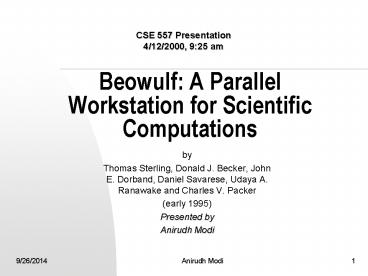Beowulf: A Parallel Workstation for Scientific Computations - PowerPoint PPT Presentation
1 / 14
Title:
Beowulf: A Parallel Workstation for Scientific Computations
Description:
Results from experiments measuring the scaling characteristics of Beowulf clusters: ... Ported to PVM from its previous version running on IBM SP-1 and Intel Paragon ... – PowerPoint PPT presentation
Number of Views:88
Avg rating:3.0/5.0
Title: Beowulf: A Parallel Workstation for Scientific Computations
1
Beowulf A Parallel Workstation for Scientific
Computations
CSE 557 Presentation 4/12/2000, 925 am
- by
- Thomas Sterling, Donald J. Becker, John E.
Dorband, Daniel Savarese, Udaya A. Ranawake and
Charles V. Packer - (early 1995)
- Presented by
- Anirudh Modi
2
Overview
- Results from experiments measuring the scaling
characteristics of Beowulf clusters - communication bandwidth
- file transfer rates
- processing performance
- Evaluation uses
- a computational fluid dynamics (CFD) code
- an N-body gravitational simulation program
- Aims to show that Beowulf architecture provides a
new operating point in price/performance for high
performance computing
3
Beowulf Architecture
- 16 single processor machines with Intel 486 DX4
100MHz chip (16 KB primary cache, 256 KB
secondary cache on the motherboard) iComp index
435, for P-III 1 GHz 3280 - 16MB RAM on every node 256 MB total
- 500 MB hard disk on every node 8 GB total
- Two 10baseT ethernet adapters on every node
- Operating system Linux (kernel v 1.1), with PVM
for parallel programming - Note This work was done in 1994, when this was
top of the line PC architecture!!!
4
Internode Communications
- Several ethernets on each node are tied by
channel bonding at device driver level. - Routing of packets is thus transparent to the
calling program, since the ethernet device driver
takes care of this. - The device driver was written by one of the
authors, Donald Becker. - User Datagram Protocol (UDP) was used to perform
token exchanges used to measure network
throughput. - Processors communicate in pairs for the benchmark.
5
Internode Communications
- Theoretical peak speed of 10baseT ethernet 10
Mbits/sec 1.25 MB/sec - of channels was varied from 1-3 for the tests
(only 4 pairs of processors were used for the 3
channel test owing to the lack of more ethernet
cards) - Token size was varied from 64 bytes to 8192 bytes
- Rountrip time was also used as a performance
characteristic defined as time taken by the
token to return to the original sender after
visiting all the intermediate nodes once (15
visits in this case)
6
Internode Communications
(Note Higher throughput is better)
7
Internode Communications
(Note Lower Round Trip time is better)
8
Internode Communications
- Performance summary
- Peak throughput obtained was
- 1 channel 1.0 MB/s (80 of theoretical peak)
- 2 channels 1.7 MB/s (68 of theoretical peak)
- 3 channels 2.4 MB/s (64 of theoretical peak)
- 4-pair 8192 byte token gives best network
throughput followed by 4-pair 1024 byte case - Rountrip time is constant (10ms for socket
connection, 60ms using PVM) till a token size of
1024 bytes, after which it increases
exponentially! - A token size of 1024 bytes is ideal from the
above results
9
Parallel Disk I/O
- Simultaneous file transfers involving varying
file sizes were carried on across a mix of
interprocessor copies and intraprocessor copies. - File copies were performed using Unix read() and
write() system calls. - Remote file transfers were carried on using BSD
sockets and UDP. - File sizes were varied from 1 MB to 16 MB.
- Remote file transfers were done in pairs, hence
upto 8 simultaneous copies were possible (only 7
could be executed since only 15 nodes were
available at the time of the experiment). - No processor was involved in more than one file
transfer, therefore no disk or processor
contention, only bandwidth contention.
10
Parallel Disk I/O
(Note Higher throughput is better)
11
Benchmark of Scientific Codes
- A 2-D compressible fluid dynamics (CFD) code
called Prometheus was used. - The code solves Eulers equation for gas dynamics
- Uses structured rectangular mesh with Piecewise
Parabolic Method (PPM) - Ported to PVM from its previous version running
on IBM SP-1 and Intel Paragon - Domain decomposition was used for parallelization
with 128x128 nodes for each processor. - N-body simulation code was also used for the
benchmark - Code used to study the structure of gravitating,
star forming, interstellar clouds. - It has runtime of O(NlogN).
- A range of particles from 32K to 256K were used.
12
Benchmark of Scientific Codes
(Note Higher Speedup is better)
13
Benchmark of Scientific Codes
- Summary of results
- CFD simulation
- Good scaling characteristics (almost linear)
performance for 16 processor case was just 16
below ideal. - Single processor performance was 4.5 Mflops,
whereas performance with 16 processors was 60
Mflops (Speedup of 13.3). - Cray T3D was 2.5 times slower for 16 processor
case!! - N-body simulation
- Scaling characteristics poorer, but not bad
performance for 8 processor case was 19 below
ideal. - Single processor performance was 1.9 Mflops,
whereas performance with 8 processors was 12.4
Mflops (Speedup of 6.5).
14
Conclusions
- Interprocessor communication proved to be the
most interesting aspect of the Beowulf cluster. - Channel bonding showed excellent scaling factors.
- Parallel file transfers seemed to be limited by
the network bandwidth. - Scientific codes showed good performance and
scaling characteristics. - Excellent price/performance about 10-20 times
cheaper than supercomputers with similar
performance. - Architecture should benefit from future
technological advances in networking, processor
speeds, disk speeds, etc. and with improvements
in software/OS.

